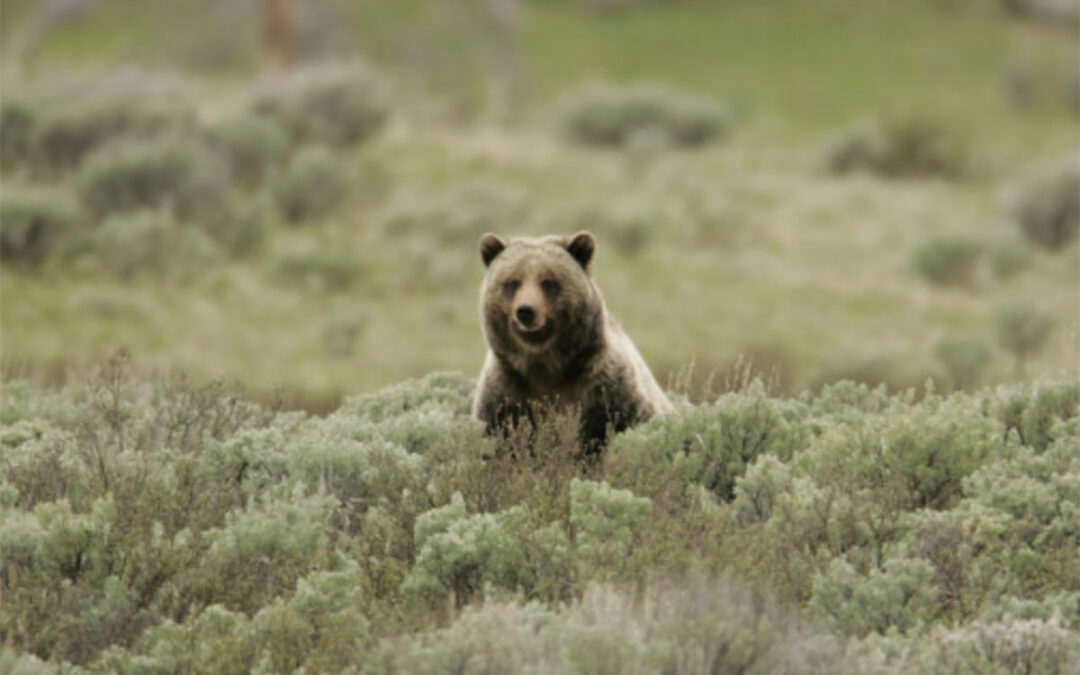Yellowstone grizzly. Photo: National Park Service.
The Tenth Circuit Court of Appeals ruled in favor of the Alliance for the Wild Rockies, Western Watershed Project and Yellowstone to Uintas Coalition on May 25th on our lawsuit over livestock grazing on 267 square miles of National Forests in the Upper Green River and Gros Ventre River drainages near the southern end of the Greater Yellowstone Ecosystem.
The Tenth Circuit Court of Appeals ruled in favor of the Alliance for the Wild Rockies, Western Watershed Project and Yellowstone to Uintas Coalition on May 25th on our lawsuit over livestock grazing on 267 square miles of National Forests in the Upper Green River and Gros Ventre River drainages near the southern end of the Greater Yellowstone Ecosystem. The Biological Opinion, issued by the U.S. Fish and Wildlife Service projected that extending these grazing allotments authorized the killing of up to 72 grizzly bears over the ten-years.
The court found that the U.S. Fish and Wildlife Service’s failure to consider limiting the number of female grizzly bears that could be killed was arbitrary and capricious because killing too many females could jeopardize the grizzly bear population in the project area. In so holding the court acknowledged the importance of protecting female grizzly bears for grizzly bear recovery. The decision placed no limits on killing female bears or cubs, even though females with cubs live where the proposed killing would be permitted.
The judges also ruled that the Forest Service failed to follow its own Forest Plan requirements regarding wildlife habitat protections for migratory birds. Some 96% of the lands approved for livestock is zoned in the Forest Plan for a wildlife protection emphasis instead.
Once over 50,000 strong in the lower 48 states, grizzlies were reduced to less than 1,000 bears. Grizzly bears were eliminated from Texas by 1890, California by 1922, Utah by 1923, Oregon by 1931, New Mexico by 1933, and Arizona by 1935.
Thus, in a historical blink of an eye, from the 1800s to the early 1900s, humans decimated grizzly populations and thereby reduced their range to less than 2% of their former range south of Canada, limiting the bear to a few isolated populations in fragmented wildlands. One of these remnant and isolated grizzly bear populations is found in the Greater Yellowstone Ecosystem.
Yet, the Bridger-Teton National Forest’s Pinedale District issued their decision to continue livestock grazing on some 267 square miles of National Forests in the grizzly habitat in the Greater Yellowstone Ecosystem. The Biological Opinion, issued by the U.S. Fish and Wildlife Service projected that extending these grazing allotments will result in the deaths of an estimated 72 grizzly bears over the ten-years.
Before grizzly bears can be recovered and delisted, we need safeguards in place to ensure that the grizzly breeding population gets adequate protections from being shot and killed by the livestock industry. We have tens of millions of cattle in America but we only have about 700 grizzly bears in the Greater Yellowstone Ecosystem which is why we are thrilled that the court sent the agencies back to the drawing board.
Federal district courts have already ruled twice that grizzly bears in the Greater Yellowstone Ecosystem still need to be protected under the Endangered Species Act — and did so for very good reasons. Chief among them is the Yellowstone grizzlies’ isolation from other grizzly populations that may cause irreversible inbreeding and lead to the extinction of the Yellowstone Ecosystem’s grizzly population.
Adding to the Yellowstone grizzlies’ many challenges, due to global warming, the drastic die-off of whitebark pines have decimated the production of their seeds, another high nutrition traditional food source, forcing grizzly bears to expand their range into less secure habitat where they are often shot and killed for reasons like cattle depredation.
The grizzly’s natural characteristics make it particularly vulnerable due to its late age at first reproduction, small litter sizes, and the long interval between litters – all of which lead to one of the slowest reproductive rates of North American mammals. A female grizzly can replace herself with one breeding age female in the first decade of her life. One – and only if she survives to breeding age and doesn’t get shot by a rancher or poacher or Wildlife Service gunner first.
There are simple steps that ranchers can take to protect their cattle from grizzly bears. These include guard dogs, selective deployment of electric fences, closer monitoring of cattle by ranchers, relocation of cattle pastures during key periods of livestock susceptibility, and removal of cattle carcasses so they don’t become a food source for grizzlies. The solution here is to better manage cattle grazing operations instead of trying to manage grizzly bears by killing every grizzly they see near a cow.
While there is little or no scientific evidence supporting killing numerous grizzly bears every year to resolve cattle-related conflicts, there is scientific evidence that non-lethal measures can reduce levels of cattle depredation by grizzlies for sustained periods of time. Simply put, if cattle ranchers refuse to use these non-lethal measures to reduce conflict with grizzly bears, the most effective means for resolving depredation-related conflicts is the termination of cattle grazing allotments on public lands that suffer from chronic cattle-grizzly conflict.
This fight is not over. The 10th circuit court of appeals sent it back to the Forest Service’s drawing boards. Please consider making a donation to help us continue our fight to recover grizzly bears.
Mike Garrity is the executive director of the Alliance for the Wild Rockies.
